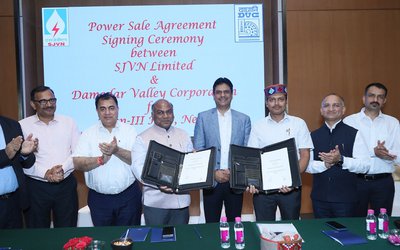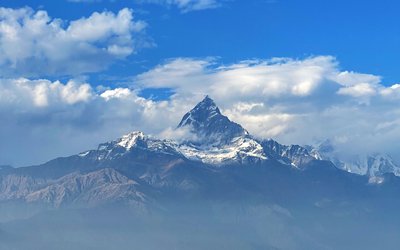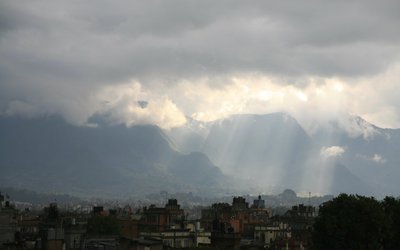
At a time when other priority development projects are showing dismal performances, the progress made by 456 MW Upper Tamakosi, a mammoth power project under construction with Nepalese resources, is well on course to meet the target for its completion by middle of 2016. This project, upon completion, will usher in a new era of Nepalese power sector turning Dolakha District into Nepal’s main player in electricity generation Pemba Norbu Sherpa, 62, former chairman of Lamabagar Village Development Committee, 250 kilometer northeast of Capital Kathmandu, did not think that his village would have a road or a dam in Upper Tamakosi to generate energy enough to meet three to four hours of the total need of the country.
“We used to walk three days to reach Lamabagar from Dolakha. Along with hydropower, our village is now connected with the rest of the country,” said Pemba Norbu. "If another 14 kilometers of the road is constructed, our village will connect to the border village of Tibetan Autonomous Region of China.”
Within the last five years, Norbu, who also worked for two years in Qatar, has seen great transformations in his village: electricity, road and school. Constructed by Upper Tamakosi Company, the 68-kilometer all-weather Charikot-Lamabagar road has transformed the entire northern belt of the Dolakha district.
With population of around 300 hundred, Lamabagar Village, Ward No 2, of Lamabagar Village Development Committee, has been witnessing a rush of workers and vehicles, busy constructing the dam to bring the water at an underground powerhouse at Gonger through an 8-kilometer long tunnel. The 456-MW Upper Tamakosi will feed 2281 Gwh power to the national grid.
“Power project is good for us. After completion of the construction, the rush will drastically go down. However, our future in this village lies on the linking road to Tibet,” said Norbu.
Although there is a rush and hush-hush for political bargaining, demonstrations and unending debates over the constitution in Nepal’s capital Kathmandu, which faces acute power shortage, the situation in Gongar and Lamabagar is very different as heavy vehicles and machineries are moving here and there at the dam site and foremen and engineers working deep inside tunnels, preparing the underground powerhouse.
Whatever political development may be taking place in capital Kathmandu, the individuals involved in the project are more concerned about how to complete the project on schedule and generate electricity to feed the power hungry residents of the capital.
Dolakha District has had a very little economic significance till now. After the completion of Upper Tamakosi, the district will be a key player in Nepal’s internal power generation and it will remain so for some time to come. It will also shift the power base from west to Eastern Nepal.
“Given the current pace, the project will start generation of electricity by July 2016. This is our revised target,” said Bigyan Shrestha, project manager of Upper Tamakosi Hydro Power Ltd. “We have almost completed over 70 percent of civil works. Out of 113, laying foundation of 37 towrs for Transmission Lines is underway and foundation of 12 towers has already completed so far. Our target is to complete 97 towers.” Shrestha has been with the project for almost six years now.
For this mammoth hydropower project, China’s Sino Hydro Corporation Ltd has been given the responsibility for Civil Work, India's Texmaco Rail and Engineering Ltd for Hydro mechanical work, Austria’s Andriaz Hydro GMBH and Mechanical and Electric by Andriaz Hydro GMBH of Austria and India’s KEC Ltd given contract for Transmission Line and Substation.
Finally, the overall consultant responsibility to inspect the project construction is given to Norwegian and German Joint Ventrue, Norconsult as- Lahmeyer International GMBH (JVNL).
The works on hydro mechanical work and mechanical and electrical work are also going on side by side. China’s Sino Hydro Corporation Ltd is in line following the schedule in civil works in Upper Tamakosi proving that it is efficient and reliable. Similarly, Indian and Austrian companies are involved in electro mechanical and hydro-mechanical and Transmission line as per the schedule.
Although the project has already seen seven governments in the last seven years, including those of Girija Prasad Koirala, Pushpa Kamal Dahal Prachanda, Madhav Kumar Nepal, Jhalnath Khanal, Dr. Baburam Bhattarai, Khil Raj Regmi and Sushil Koirala in the five years, the progress of the project has been constant, no matter who led the governments.
With the active support from all in the political spectrum and people of the district, the instability in the capital has made little impact on the project construction. “We just want to see the movement of vehicles to continue as the project needs to carry out a lot of materials to the project,” said an official. “If politicians want to give us favor, we ask them not to disturb the mobility of vehicles or call bandh.”
As frequent strikes called by political parties, including the forty-two days of general strikes called in far western region in 2012 badly shook the Chameliya project, escalating the total cost as well as uncertainty over the completion, Upper Tamakosi has not seen such persistent disturbances.
Compared to other NEA’s directly handled projects, including Chameliya and Kulekhani III, Upper Tamakosi has followed a different model or construction under autonomous company model. Although NEA is the largest shareholder, the Upper Tamakoshi Ltd has fully autonomous functions to decide on payment and other internal matters.
Run under the Nepal Electricity Authority’s direct management, Chameliya and Kulekhani are struggling at the final stage of completion. Upper Tamakosi III, which is under Upper Tamakosi Hydropower Ltd, is performing far better in terms of the progress it has made so far.
Despite facing several hurdles at different levels, even non-cooperation of the concerned government offices, Upper Tamakosi has been performing well because of its independence and easier working procedures than other NEA managed projects.
Team Spirit
Although all the senior and junior engineers working at Upper Tamakosi are deputed by NEA, their performance in Upper Tamakosi is much higher than in NEA’s own projects.
Along with Chief Executive Officer Bigyan Shrestha, who looks after all administrative and managerial functions at Kathmandu and project sites, Bimal Gurung, a young and dynamic Assistant manager of NEA commands the work in project sites. Similarly, Manager Pradip Thike,deputy Manager Mohan Gautam and enviornmentalist Dr.Ganesh Neupane and all others.
The whole group of Nepalese engineers and other staff at the project site Gonger, Lamabagar and Kathmandu is pushing the pace. They have been working day and night, public holiday or festival to maintain the pace of construction work by mobilizing other manpower.
Thanks to the dedication and hard work of the project staffs, Upper Tamakosi has been able to achieve the progress. Although there is a certain incentive in the project, the employees are more guided by dedication and commitment.
“Along with looking at the construction work, I have to visit different ministries, attend meetings and perform all financial and administrative works,” said Shrestha.
Project Model
Situated in Upper Lamabagar 60.0 meter x 220 meter dam diverts the water to the underground power house situated in Gonger Village through 8.4 kilometer long tunnel and the water will discharge through 3 Kilometer long tail race. The dam will store 1.2 cusec meter of water. It will produce 2281 Gwh energy in a year. The electricity will be connected to Khimti Substation through 47 kilometer long 220 KV double circuit transmission.
Along with the construction work for the project, the Upper Tamakosi has also constructed the 68-kilometer long Dolakha Lamabagar road. Over 71 percent work has already completed and 21.10 billion rupees has already dispersed by end of November 2014.
Structure of Financing
Although Upper Tamakosi is a project with total investment of Nepalese financial institutions, involvement of various international companies has made it really a multi-national endeavor.
The shareholders of Upper Tamakosi include Nepal Electricity Authority (41%), Nepal Telecom (6 percent), Citizen Investment Fund (2) and National Insurance Corporation (2), local residents of Dolakha District (10 percent), general public (15), depositor of Employment Provident Fund (17.28), employees of company and NEA (2.84) and employees of other lender companies (2.88).
Employment Provident Fund has Rs. 10 billion, Nepal Telecom Rs. 6 billion, Citizenship Investment Fund and National Insurance Corporation Rs. 2 billion each in the project. Nepal government provides Rs. 11.08 billion. The total estimated cost of the project is Rs. 35.09 billion at the cost of 2009.
Given the rise of US dollars by over 30 percent in the last six years, the project cost is likely to escalate. Despite escalation of certain percentage, Upper Tamakosi is still a cheaper project than several others.
The construction work of 456 MW Upper Tamakosi, Nepal’s largest project, is going on smoothly. The project is expected to generate power by July, 2016. Upper Tamakosi is the first mega project which is constructed under Nepal’s own resources.
When then NEA Managing Director, now secretary at Ministry of Urban Development Arjun Karki, who is also a resident of Dolakha District, proposed NEA's willingness to construct the project with Nepali investment, nobody was ready to buy the idea. Determined to carry out the project, Karki pushed the proposal and finally got the nod.
Seven years down the lane, Upper Tamakosi is now almost at the completion stage. With the construction of the mammoth 456 MW Upper Tamakosi hydro power project, Nepalese will have shown that they have the capability, will and financial resources as well to realize the dream of people like Norbu Sherpa as well as that of the Nepalese to live in a situation without any power hiccup.

Keshab Poudel
Poudel is the editor of New Spotlight Magazine.
- FOURTH PROFESSOR Y.N. KHANAL LECTURE: Nepal-China Relations
- Jun 23, 2025
- Colonel JP CROSS: Centenary Birthday
- Jun 23, 2025
- REEEP-GREEN: Empowering Communities with MEP
- Jun 16, 2025
- BEEN: Retrofitted For Green
- May 28, 2025
- GGGI has been promoting green growth in Nepal for a decade: Dr. Malle Fofana
- May 21, 2025















